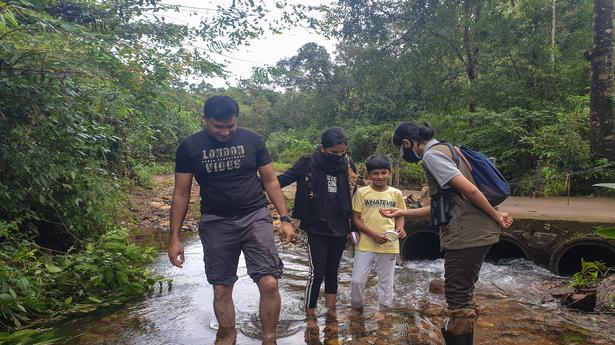
Nature guides introduce the flora and fauna of the Western and Eastern Ghats to trekkers and visitors
The Hindu
A surge in monsoon travel, fuelled by Indians focussing on the great outdoors this year, has fuelled a rise in imaginative treks, where guides teach you everything from photographing amphibians to counting stars
As the monsoon embraces the Western Ghats, the forests come alive. Noisy frogs call their mates while crickets, cicadas and grasshoppers compose the background score. Wind whistles through leaves as forest streams gurgle with renewed vigour. Bats, flying foxes and gliding frogs silently swoop through the canopy, while night moths glide between the foliage.
The ideal time to meet these denizens of the wild in their habitat is when the rain-soaked hills are carpeted in green. As monsoon travel regains pace after a tough couple of years, Nature walks, led by guides who focus on birding, herping, mammals and local flora are getting increasingly popular.
In the Western Ghats, David Raju, general manager of Wayanad Lodge, CGH Earth Wayanad and a veteran naturalist, points out that there are certain species, both flora and fauna, endemic to the region. “We introduce visitors to bird, frog and snake species in addition to butterflies, moths and mammals.” Malabar grey hornbill, Grey-headed bulbul, Nilgiri wood pigeon, Flame-throated bulbul, Malabar gliding frog, Waterdrop frog, Winged gliding frog, Indian rock python and Malabar vine snake are some of the usually spotted species.
Nature guides also connect the tourists to local communities, resulting in memorable travel with a positive impact. Thorthey Gooden, a Toda Nature guide in the Nilgiris, introduces tourist groups to the flora and fauna around his village by narrating stories about the plants, mountains and the Toda way of life. “I tell how in the past the monsoon was so heavy, our buffaloes, which are left outdoors, would have fungi growing on their horns. But not any longer,” he says, adding that he also explains how their ancestors were food gatherers. “I show them the berries and plants we consume as the Todas are vegetarians.”
R Yeshwanth Kumar, a Nature guide working with a resort near Udhagamandalam, says that in the Nilgiris, leopards and an occasional tiger can also be spotted sunning on rocks or in the vicinity of villages during the rains, in addition to sambar, barking deer and lion-tailed macaques.
In Gudalur in Tamil Nadu, K Satheeshan says he notices that visitors from North India in particular, “are enchanted by the numerous waterfalls, streams and rivulets that criss-cross the hills. If we are lucky, we see herds of elephants and bisons in the evening.”
Sumit Sharat Kamble, a naturalist in Machan Plantation in Sakleshpur district, Karnataka, says he has noticed an increasing number of visitors from the city ever since pandemic restrictions began to ease. Prior to his stint in Karnataka, Sumit used to take visitors on walks in Matheran, Amboli Ghat and Lonavla in Maharashtra. At this time of the year, it is the breeding season for birds like Indian pitha, Malabar whistling thrush, Oriental Dwarf kingfisher and Sahyadri sunbird.











